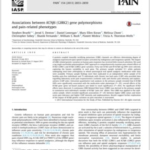Calcineurin-inhibitors CI are immunosuppressive agents prescribed to patients after solid organ transplant to prevent rejection. Although these drugs have been transformative for allograft survival, long-term use is complicated by side effects including nephrotoxicity. Given the narrow therapeutic index of CI, therapeutic drug monitoring is used to prevent acute rejection from underdosing and acute toxicity from […]
Tag Archives: Adult
Utilization of an EMR-biorepository to identify the genetic predictors of calcineurin-inhibitor toxicity in heart transplant recipients.
Oetjens M, Bush WS, Birdwell KA, Dilks HH, Bowton EA, Denny JC, Wilke RA, Roden DM, Crawford DC,. Calcineurin-inhibitors CI are immunosuppressive agents prescribed to patients after solid organ transplant to prevent rejection. Although these drugs have been transformative for allograft survival, long-term use is complicated by side effects including nephrotoxicity. Given the narrow therapeutic […]
Associations between KCNJ6 (GIRK2) gene polymorphisms and pain-related phenotypes.
G-protein coupled inwardly rectifying potassium (GIRK) channels are effectors determining degree of analgesia experienced upon opioid receptor activation by endogenous and exogenous opioids. The impact of GIRK-related genetic variation on human pain responses has received little research attention. We used a tag single nucleotide polymorphism (SNP) approach to comprehensively examine pain-related effects of KCNJ3 (GIRK1) […]
Associations between KCNJ6 (GIRK2) gene polymorphisms and pain-related phenotypes.
Bruehl S, Denton JS, Lonergan D, Koran ME, Chont M, Sobey C, Fernando S, Bush WS, Mishra P, Thornton-Wells TA,. G-protein coupled inwardly rectifying potassium (GIRK) channels are effectors determining degree of analgesia experienced upon opioid receptor activation by endogenous and exogenous opioids. The impact of GIRK-related genetic variation on human pain responses has received […]




